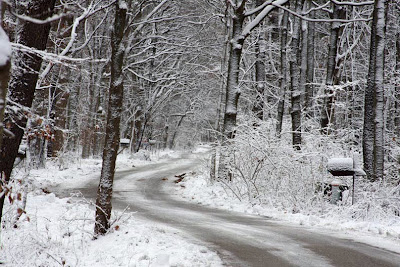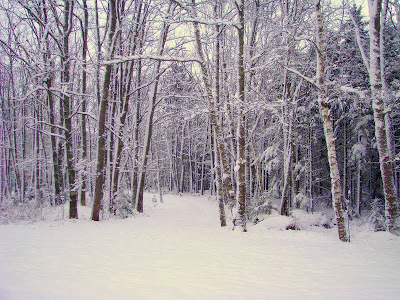So far we have had 34.8 inches of snow this month of January. The previous January record was 26 inches in 1947, the first year statistics were kept at Brookhaven National Laboratory.
This January's snow is also the most for any single month. The previous high was 32.5 inches in February 1967. By the way, February is typically the snowiest month on Long Island, according to the National Weather Service.
With 19.8 inches that fell in last month's blizzard, this season's total so far is 54.6 inches. The record was set in 1995-96 with 90.75 inches, followed by 2004-05's 78.5 inches. Right now we are in 11th place, but almost two months of winter are still ahead. The average Long Island winter brings 32 inches, according to Newsday's January 28, 2011 paper.
So, as you can see, it has been a great winter, and it isn't over yet!
Some who live in a fast-paced society and who must travel may view snow merely as an obstacle. Yet, countless others view snow as a delight, producing a winter wonderland that opens up opportunities for special activities.
What do you know about snow? In effect, that was a question Jehovah asked Job:“Have you entered into the storehouses of the snow, or do you see even the storehouses of the hail, which I have kept back for the time of distress, for the day of fight and war?”
Oh, we know what a lot of it looks like, perhaps from photos of snowbanks or because we have actually seen plenty of snow, especially this year. But what of individual snowflakes? Do you know what they look like, maybe having examined them at their source?
Some men have spent decades studying and photographing snowflakes. A snowflake may be composed of a hundred delicate ice crystals in a variety of beautiful designs. The book Atmosphere says: “The endless variety of snowflakes is legendary, and although scientists insist that no law of nature forbids their duplication, two identical flakes have never been found. One search of epic proportions was conducted by . . . Wilson A. Bentley, who spent more than 40 years examining and photographing snowflakes through a microscope without ever finding two that were exactly alike.” And even if, in a rare case, two appeared to be twins, would that really alter the wonder of the staggering variety of snowflakes?
Each snowflake becomes a masterpiece of construction. Amazingly, no two have been discovered that are exactly alike, and there are enough possible combinations of patterns to suggest that there will never be such a discovery. Yet, all are six-sided in shape!
Snow—its origin, flake growth, and design—staggers the mind of scientists.
What is snow? Snow is a clustering of ice crystals crafted from the water vapor in the air. Temperature, humidity, and barometric pressure help sculpture the beautifully symmetrical shapes of ice crystals. When the temperature near the ground is above 32° F. (0° C.) snow may reach us as rain. But if the temperature is below 32° F., the tiny crystals will clump together to form a snowflake.
But there must be something that the moisture can be formed around, something that acts as a “seed.” What can be used? Any microscopic particles floating in the air will do—dust, salt, or even pollution. Around these nuclei, ice crystals will grow into flat six-pointed stars, hexagonal pillars, or sparkling needles. As snow tumbles slowly earthward from as high as six miles (10 km), it may collide with other crystals and stick to them, or it may shatter, forming more “seeds” for more crystals.
Here are two statistics that may surprise you: A cubic foot (.028 cu m) of snow may contain 10 million snowflakes. And it has been estimated that up to one half of the earth’s land surface and 10 percent of the sea, about 48 million square miles (124 million sq km), may at times be under this wintry blanket. With all that snow, is it possible that no two snowflakes are alike? Yes!
To try to understand why, let us consider just one more set of facts. Millions of water molecules, which can be arranged in many different ways, may form a single ice crystal. And it takes from one to more than a hundred of these ice crystals to make one snowflake. According to Charles Knight, physicist at the U.S. National Center for Atmospheric Research, if you put all these numbers in a computer, you would find that there are still more possible combinations of molecules in each snowflake than there have been snowflakes in all earth’s history.
In addition, the air around a flake shapes its growth. As mentioned earlier, moisture, temperature, and barometric pressure sculpture snow. However, wind molds its shape too. All four factors may vary from moment to moment. Falling snow may pass through air masses of varying temperature. The wind may blow it through any number of temperature and humidity ranges in its downward journey. And since no two flakes are likely to follow the same path to earth, each one should indeed be unique.
Besides snow being beautiful to look at, there are vital benefits for us and the earth.
Just as many enjoy a soft, warm blanket on a cold winter night, the earth has its own winter blanket. Thanks to snow, the fluctuations in temperature of the soil are moderated. The soil holds in the heat it had absorbed before it was covered. Thus seeds are protected and crops will grow for the next harvesttime.
The earth is not just insulated by the snow blanket, however; it is also fertilized. How so? Because of the vital nitrates that are deposited by the snow. In the 1970’s it was estimated that an average snowfall on prairie farms would deposit about $20 worth of nitrates per acre.
And did you know that snow is referred to as the most effective “dam” of any kind? The water is held back or stored in the form of snow. In this form it will wait until it is released by melting in the spring. Hence, snow holds back water as a dam does. Even then, thanks to its ability to reflect the sun’s rays, the snow will melt away slowly, and in this way much of the water will filter its way down into the soil instead of just flowing off.
The Bible outlined these benefits of rain and snow by stating: “The pouring rain descends, and the snow . . . [and] actually saturates the earth and makes it produce and sprout, and seed is actually given to the sower and bread to the eater.” (Isaiah 55:10)
Yes, for many of earth’s inhabitants, the water they drink and the food they eat, and even the electricity they use, may be directly or indirectly a result of tapping “the storehouse of the snow.”
Indeed, the more scientists study snowflakes, the more they appreciate, as The New York Times reported January 6, 1987: “Snowflakes obey mathematical laws of surprising subtlety.” Do you not agree that snowflakes are a tribute to the power and wisdom of their Maker? “For to the snow he says, ‘Fall earthward.’”—Job 37:6.
By growing snow crystals in the lab under controlled conditions, scientists have discovered that their shapes are determined largely by temperature and humidity. This picture summarises the crystal shapes formed under different conditions.
 12-sided snowflake
12-sided snowflake
This is actually two snowflakes joined together - one rotated at 30 degrees relative to the other. Such snowflakes are quite rare.
May this blog about snowflakes help us better appreciate our Creator and his magnificent qualities of love, wisdom, justice, and power.
And, may we, like snowflakes, work together, to accomplish a lot!
“Snowflakes are one of nature's most fragil things. But just look at what they can do when they stick together."

This is Raven-as the crow flies!
 Snowflakes, are one of God's finest masterpieces. “How many your works are, O Jehovah! All of them in wisdom you have made. The earth is full of your productions.” Psalm 104:24; 148:1-5.
Snowflakes, are one of God's finest masterpieces. “How many your works are, O Jehovah! All of them in wisdom you have made. The earth is full of your productions.” Psalm 104:24; 148:1-5. 12-sided snowflake
12-sided snowflake This is actually two snowflakes joined together - one rotated at 30 degrees relative to the other. Such snowflakes are quite rare.
This is actually two snowflakes joined together - one rotated at 30 degrees relative to the other. Such snowflakes are quite rare. 








 This is Raven-as the crow flies!
This is Raven-as the crow flies!









 In the very earliest Roman calandar there were no months of January or February at all. The ancient Roman calandar had only 10 months and the new year started the year on March 1st. To the Romans 10 was a very important number. Even when January (or Januarius as the Romans called it) was added, The New Year continued to start in March. It remained so in England and her colonies until 200 years ago.
In the very earliest Roman calandar there were no months of January or February at all. The ancient Roman calandar had only 10 months and the new year started the year on March 1st. To the Romans 10 was a very important number. Even when January (or Januarius as the Romans called it) was added, The New Year continued to start in March. It remained so in England and her colonies until 200 years ago.

